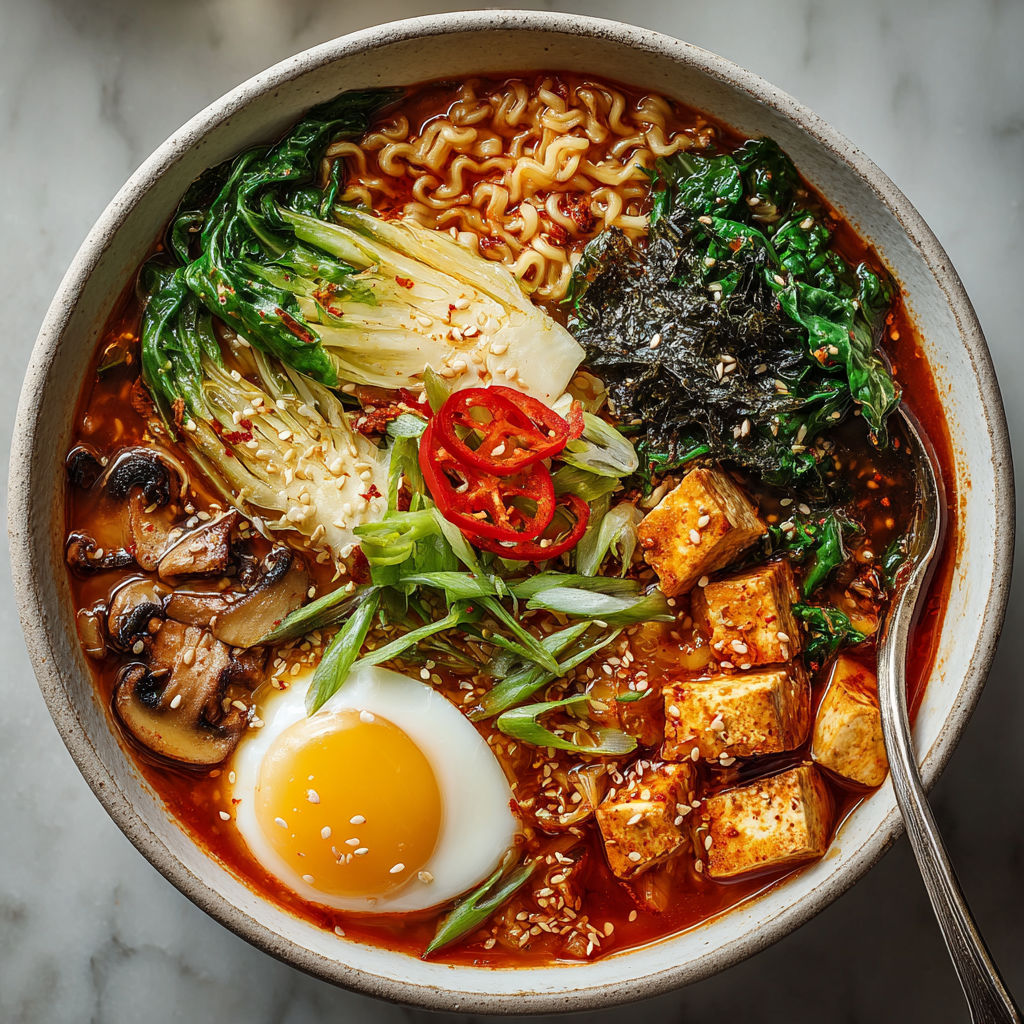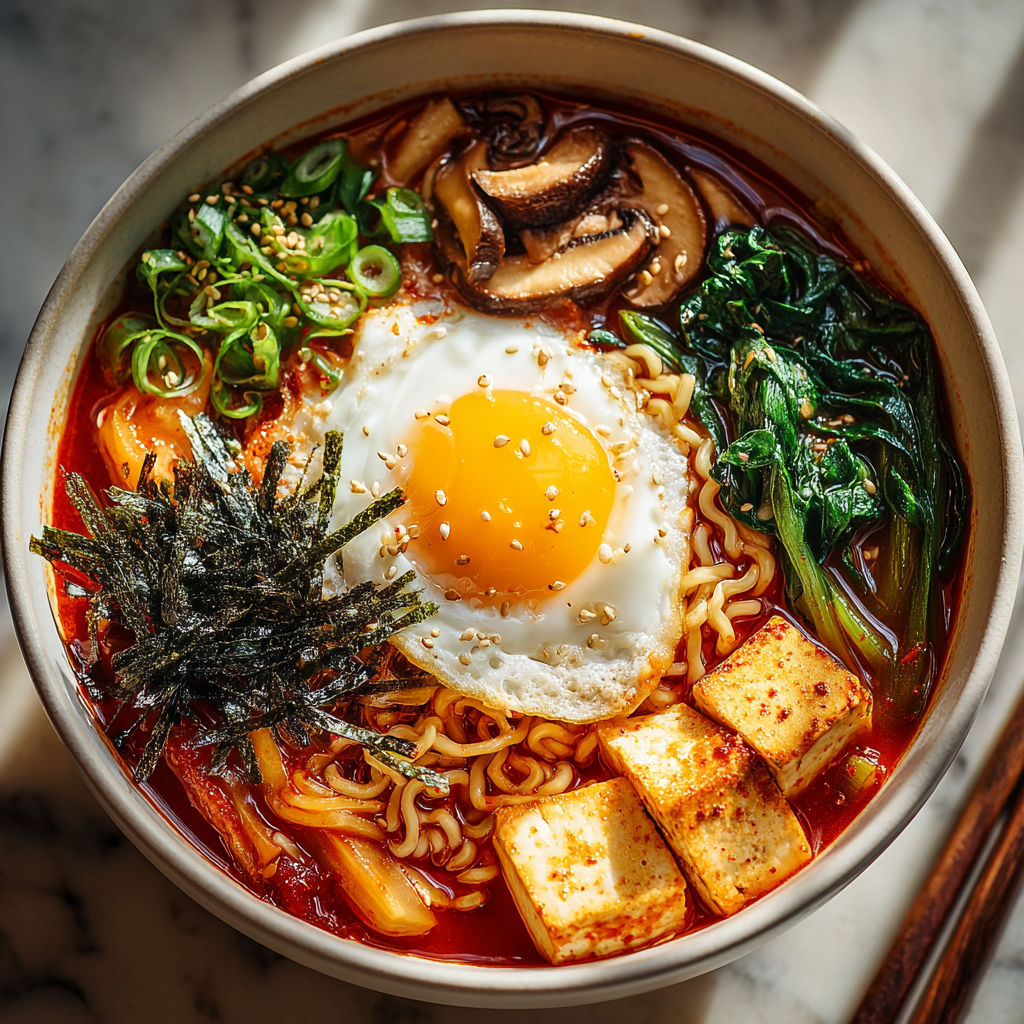 Save to Pinterest
Save to Pinterest Few dishes warm me up faster than a bowl of Korean kimchi ramen soup especially after a chilly walk or on lazy weekends when I crave both comfort and a kick of heat. The savory broth zingy kimchi chewy noodles and colorful toppings make this soup an instant mood booster and a family favorite when we want a memorable dinner in just half an hour.
When I first cooked this soup for my friends on a rainy day the kitchen filled with the scent of garlic and ginger and everyone ended up slurping their bowls clean. It has since become my go-to for warming up and showing off Korean flavors—even my pickiest eaters are now kimchi converts.
Ingredients
- Vegetable oil: provides the essential base for blooming aromatics and delivering richness
- Garlic: fresh cloves give depth and a savory backbone—choose plump firm bulbs for the best flavor
- Ginger: adds warmth and citrus notes try to use fresh ginger root and mince finely
- Onion: creates sweetness pick a small but firm yellow or white onion
- Chicken or vegetable broth: forms the foundation of your soup use low sodium and taste for quality
- Gochujang: Korean chili paste delivers signature heat and umami opt for an authentic Korean brand for best results
- Soy sauce: brings layers of salt and complexity choose natural brewed for depth
- Rice vinegar: brightens the broth select pure rice vinegar without additives
- Sesame oil: finishes the soup with nutty aroma toast your own if possible
- Ramen noodles: serve as the hearty base fresh noodles give the best chew but instant works well just skip the seasoning packet
- Napa cabbage kimchi: offers tang crunchy texture and spice the fresher the better and plenty of juice for extra zip
- Kimchi juice: intensifies the flavor pour straight from your kimchi container for a concentrated burst
- Shiitake mushrooms: add earthy savoriness fresh or rehydrated dried are both great
- Baby spinach leaves: add color and gentle bite go for vibrant green leaves
- Green onions: liven up with gentle onion flavor look for perky bright stems
- Eggs (optional): bring silkiness and protein go for large eggs at room temperature if poaching
- Firm tofu (optional): soaks up broth and adds creamy texture press to remove excess water before cubing
- Nori strips for garnish: contribute waves of umami snip fresh sheets just before serving
- Toasted sesame seeds: bring crunch and flavor toast briefly in a dry pan for extra aroma
- Extra green onions and red chili slices: for a finishing kick pick the freshest brightest chilies
Instructions
- Prepare the Aromatic Base:
- Heat vegetable oil in a large soup pot over medium heat. Add minced garlic ginger and sliced onion then cook gently for two to three minutes. Stir regularly until everything is softened and fragrant. This is your foundation for flavor.
- Bloom the Gochujang and Kimchi:
- Add the gochujang and stir into the aromatics letting the paste sizzle and bloom. Add chopped napa kimchi and continue to sauté for another two minutes. This lets the flavors meld and brings out the depth of the chili paste.
- Build the Broth:
- Pour in the kimchi juice chicken or vegetable broth soy sauce and rice vinegar. Stir well. Raise the heat slowly and bring the pot to a gentle simmer. Taste the broth to adjust salt and spice.
- Simmer Mushrooms and Tofu:
- Add shiitake mushrooms and firm tofu cubes if using. Let everything gently bubble away for five minutes. The mushrooms soak up the heat and kimchi flavor while the tofu becomes creamy and rich.
- Cook the Noodles:
- While the soup simmers fill a separate pot with water and bring to a boil. Add ramen noodles and cook according to package instructions until chewy but tender. Drain noodles and set aside. This step keeps the noodles from soaking up all the broth.
- Poach Eggs if Using:
- If you want eggs gently crack them right into the simmering soup and let them poach for three to four minutes until the whites are set and yolks still creamy.
- Finish the Soup:
- Stir in baby spinach and drizzle with sesame oil. Keep stirring until the spinach wilts beautifully.
- Assemble Your Bowl:
- Divide cooked noodles among serving bowls. Ladle the hot bubbling soup plus vegetables tofu and eggs if using over the noodles. Make sure every bowl gets a good mix.
- Garnish and Serve:
- Sprinkle each bowl with nori strips toasted sesame seeds extra green onions and red chili slices if you like it spicier. Serve piping hot and enjoy the riot of texture and taste.
 Save to Pinterest
Save to Pinterest The kimchi is always my favorite part especially when it is fresh and made at home. Each time I open a new jar I remember how my grandmother used to layer the cabbage folds with spices by hand and that memory always makes this recipe taste even better. My family loves customizing their bowls with extra toppings which makes dinner interactive and fun.
Storage Tips
Store the broth and toppings together in an airtight container but keep ramen noodles separate to preserve their texture. Reheat soup on the stove until steaming and cook fresh noodles for serving. Kimchi soup gets even more flavorful after a day in the fridge so it makes a stellar lunch or dinner prep ahead.
Ingredient Substitutions
Vegetable broth and tofu make this recipe fully plant based. If you want a milder soup reduce the gochujang or swap with sweet chili paste. For gluten free bowls use rice ramen or sweet potato noodles and double check all your sauces.
Serving Suggestions
Try serving with crunchy pickled radishes or daikon on the side for an extra fresh bite. A drizzle of chili crisp or a handful of bean sprouts ups the texture game. Serve in deep bowls for that comforting ramen shop feel or offer toppings family style for everyone to build their perfect bowl.
Cultural and Historical Context
Kimchi jjigae and ramen are both pillars of Korean and Japanese comfort food. This hybrid soup draws on traditional kimchi stews and brings in the fun format of ramen with noodles for slurping. Both dishes reflect a loving use of leftovers and preserved flavors that have fed many generations.
Seasonal Adaptations
Swap in bok choy or kale for spinach in cooler months Add thinly sliced carrots or snap peas for early spring or summer versions Make it richer by topping with a soft boiled egg for wintery nights
Success Stories
One cold night I had only a half jar of kimchi and instant ramen packets in the pantry. This soup came together so quickly and everyone went back for seconds. Now even the younger kids ask for the spicy broth by name.
Freezer Meal Conversion
You can freeze the broth with mushrooms tofu and kimchi for up to one month. Just cook fresh noodles before serving and store any fresh toppings separately. The soup base tastes even deeper after a stint in the freezer and is the ultimate quick meal when time is tight.
 Save to Pinterest
Save to Pinterest This spicy kimchi ramen soup is a true hug in a bowl and easy enough for any weeknight. Enjoy every warming bite and make it your own with a mix of favorite toppings.
Common Recipe Questions
- → How spicy is Korean kimchi ramen?
The spice level depends on the amount of gochujang and kimchi used. Adjust both for milder or bolder heat.
- → Can I make this vegetarian or vegan?
Yes, use vegetable broth and omit eggs or meat. Substitute tofu for added protein in a vegan version.
- → Are instant noodles suitable for this dish?
Fresh or instant noodles work well—just discard any seasoning packets to control the flavor and sodium.
- → What toppings pair best with this ramen?
Top with nori strips, sesame seeds, green onions, and chili slices for extra flavor and crunch.
- → How can I adjust the broth flavor?
Add more soy sauce for saltiness, rice vinegar for tang, or gochujang for a deeper, spicier profile.